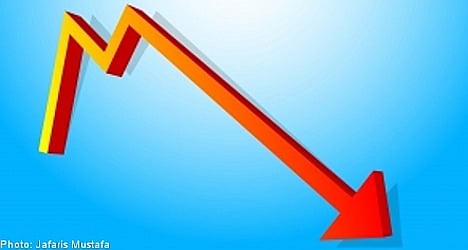While Sweden’s gross domestic product (GDP) actually grew by 1.1 percent during the fourth quarter of 2011 compared to the same period in 2010, the rate was well below the 2.6 percent estimated by analysts, according to new figures from Statistics Sweden (Statistiska Centralbyrån, SCB).
The GDP figures for the fourth quarter were weaker than what had been expected by analysts, who had been predicting a rise by 2.6 percent compared to the same period in 2010 and a 0.8 percent decrease compared to the third quarter, according to news agency Reuters.
“That is a weak figure, even weaker than we had predicted and a lot worse than anticipated by the Riksbank,” said head economist at Swedish bank Nordea, Annika Winsth, to news agency TT.
“The consequence will be that the Riksbank will have to continue to cut interest rates,” said Winsth, who predicts a drop in repo rate to 0.75 percent by September.
The report showed that Swedish household consumption expenditures rose by 0.7 percent and general government consumption expenditures increased by 0.8 percent during the fourth quarter of 2011.
Export increased by 0.6 percent and the import by 1.6 percent.
According to the report, Swedish export was affected by the the unstable international conditions and the net export showed a negative development for the first time since the second quarter of 2010, pulling down the GDP by 0.4 percentage points.
Seen over the whole of 2011 the GDP increased by 3.9 percent compared to 2010. Household spending rose by 2.1 percent. Transport costs and Swedes spending money abroad contributed most to the rise.
The figures also showed a rise in public spending by 1.8 percent over the whole of 2011, with export increasing by 6.8 percent and import by 6.1 percent.
Tor Borg, an analyst with SBAB bank, said that the growth figures, just as earlier inflation figures, were well below the Riksbank’s prognosis.
“We are expecting them to cut interest rates by 0.25 percentage points at the next meeting, and these figures are endorsing that prediction a little,” Borg told TT.
The results for spending and export is what is especially worrying, according to Borg.
“Spending and export is somehow at the very centre of growth,” he told TT.
Two weeks ago, the central bank cut its key rate by 0.25 points to 1.50 percent, citing a weaker economic outlook due to dwindling growth in the neighbouring eurozone.
Europe accounts for 70 percent of Sweden’s exports.
Ben May, an economist at Capital Economics research consultancy, said the fourth-quarter figure “brought the strongest evidence yet that the problems in the eurozone are taking their toll on Europe’s healthiest economies.”
Swedish finance minister Anders Borg also commented on Sweden’s apparent economic slowdown.
“It’s very clear that the Swedish economy stood still in October, November, December. They were very weak months,” Borg told TT.
“This shows that Sweden is an open, small and dependent country. We are always affected when there is risk around us,” he said.
He added that “several measures are being taken to stabilise the situation,” but did not specify what those moves were.
Finance minister Borg said it was important to exercise caution and ensure that Sweden maintained maneuvrability in its economy, and said he saw two trends that were affecting the Swedish economy.
“On the one hand, the situation developed weakly at the end of last year, on the other hand, it looks like there has been a significant decline in uncertainty over the global economy.”
Sweden has registered consistent growth since the second quarter of 2009, when it exited a one-year recession.



 Please whitelist us to continue reading.
Please whitelist us to continue reading.
Member comments